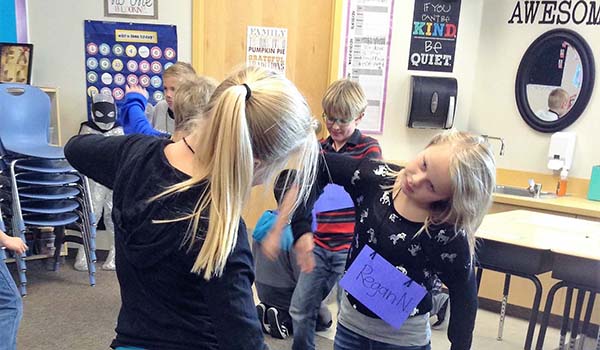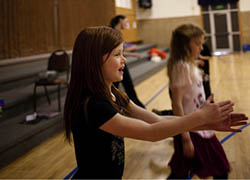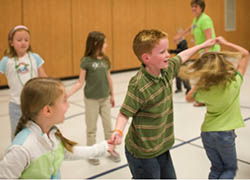SUBJECTS
GRADE
Show Results
Heredity

Lesson Summary
- Identify how various organisms adapt in different environments.
- Explore traits and characteristics of different organisms through dance.
Lesson Plan and Procedure
Lesson Key Facts
- Grade(s): 1, 3
- Subject(s): Dance, Science, Social Studies
- Duration of lesson: 40 minutes
- Author(s): Jana Shumway
Experience/Identify
Define organism as any living thing that carries out life activities on its own.
Define traits as characteristics that determine how an organism looks, acts, or functions.
The following activities give students a chance to move like different organisms based on their traits.
| Organism | Trait | Dance/Movement |
|---|---|---|
| Human | Walks on two legs | Walk around the room to the beat of the music |
| Animal | Walks on four legs | Walk on hands and feet |
| Bird | Flies in the air | Fly around the room with arms outstretched |
| Insect | Has six legs | With a partner, create a shape with six legs and walk around the room |
| Plant | Grows from the ground | Start low and grow high |
| Bacterium | Is incredibly small | Get really small and move in really minute way |
Explore/Investigate
Divide the class into two groups: parents and offspring. Have each parent pick one offspring to be his or her partner. Discuss heredity, inherited traits, and learned traits. Place a card with the definition of each on the board.
- Heredity: The passing of traits from parents to their offspring
- Inherited traits: Characteristics passed from parents to their offspring
- Learned traits: Characteristics or behaviors that are learned by following the examples of the parents
In pairs, have the offspring copy the movement of their parent. Model with a student how this could look.
Teacher: If I were doing human movements on two legs, I would show my offspring how to _________ (tiptoe, walk backward, skip, jump in circles, and so on), and he or she will have to copy as close as he or she can everything I am doing and thus inherit my traits.
After modeling an example, allow the students to dance their assigned part, either as leader (parent) or follower (offspring).
Use the drum for accompaniment. With each activity, switch roles and have the offspring copy the varied movement of the parent.
| Organism | Trait | Dance/Movement |
|---|---|---|
| Human | Stands on two legs | Tiptoe, walk backward, skip, jump, run, leap, and spin |
| Animal | Stands on four legs | Move high, low, and sideways with small and large steps |
| Bird | Flies through the air | Flap around the classroom by diving and swooping low and high |
| Insect | Moves on six legs | Crawl on hands and feet slowly |
| Plant | Grows from the ground | Twist straight, wide, symmetrical, low to high, and side to side |
| Bacterium | Is incredibly small | Bend down in a small shape and move around with arms twisted, heads tucked, and legs squared |

Create/Perform
Discuss the concept of species and specialized structures. Put a card on the board with the definitions on it.
- Species: Groups of plants or animals that can only reproduce among themselves
- Specialized structures: Body parts unique to a certain organism (examples listed below)
- Snowshoe rabbit: Lives in a cold environment, has small ears to keep in the heat, and has broad feet to travel on the snow
- Jackrabbit: Lives in hot, dry areas; has long ears to release heat; and has powerful hind legs to outrun predators
- Woodpecker: Has a climbing foot
- Duck: Has a swimming foot
- Emu: Has a running foot
- Hawk: Has a grasping foot
Discuss environment as the surrounding in which an organism lives.
Play “Sun of Jamaica” by Cusco.
Have the students get into groups of four or five. Assign each group an environment (swamp, forest, ocean, arctic, desert, savanna, and so on). Have the students create with their bodies an imaginary animal and give it traits that it would need in order to survive in its environment.
Create the shape of the animal as a group. Each child will represent one trait. Name the animals. Have the children show their animals to the class.
When they show the animal, state the environment it lives in. Have all the students who are observing make shapes like that environment. (For example, they might make cacti and sand for desert.) The group performing will state the animal’s name, and then move like their imaginary animal would move through the student-created environment.

Connect/Analyze
Discuss the special structures that each group chose for their animal to adapt to fit into their environment. Discuss the effectiveness of having these traits as opposed to others.
Learning Objectives
- Understand that traits are passed from parents to offspring.
- Identify variations between parents and offspring.
- Identify traits that are helpful or unhelpful, depending on the environment.
- Compare the dances of others and the aspects that made them unique.
- Collaborate with peers to create a unified dance.
- Refine spatial relationships between members of a dance.
Utah State Board of Education Standards
This lesson can be used to meet standards in many grades and subject areas. We will highlight one grade’s standards to give an example of application.
Grade 3 Science with Engineering Education (SEEd)
Standard 3.2.3: Construct an explanation that the environment can affect the traits of an organism. Examples could include that the growth of normally tall plants is stunted with insufficient water or that pets given too much food and little exercise may become overweight. (LS3.B)
Standard 3.2.4: Construct an explanation showing how variations in traits and behaviors can affect the ability of an individual to survive and reproduce. Examples of traits could include large thorns protecting a plant from being eaten or strong smelling flowers to attracting certain pollinators. Examples of behaviors could include animals living in groups for protection or migrating to find more food. (LS2.D, LS4.B)
Standard 3.2.5: Engage in argument from evidence that in a particular habitat (system) some organisms can survive well, some survive less well, and some cannot survive at all. Emphasize that organisms and habitats form systems in which the parts depend upon each other. Examples of evidence could include needs and characteristics of the organisms and habitats involved such as cacti growing in dry, sandy soil but not surviving in wet, saturated soil. (LS4.C)
Grade 3 Dance
Standard 3.D.CR.1: Demonstrate willingness to take turns leading and following when creating dance with others.
Standard 3.D.P.7: Recall movement sequences with a partner or in group dance activities.
Standard 3.D.CO.1: Respond to a dance work using a set of questions, create movement using ideas from responses, and explain how certain movements express a specific idea.
Grade 3 Social Studies
Standard 3.2.2: Describe how geography (that is, physical features and natural resources) has shaped where and how their community developed, how it sustains itself, and how it will sustain itself in the future.
Standard 3.4.1: Choose a community outside of the United States. Locate that community on both print and digital maps of the Earth, their continent, country, and city or town, and contrast their sizes and the relationships in scale.
Standard 3.4.2: Research the geography (that is, physical features and natural resources) of the community they chose in 3.4.1, and make inferences regarding how the geography influenced the cultures that have developed there.
Standard 3.4.5: Examine how and why the community they chose in 3.4.1 has adapted to and/or modified its environment over time, and identify the consequences of these environmental changes.
Equipment and Materials Needed
- Drum
- Music track: “Sun of Jamaica” by Cusco
- Definition cards for the following:
- Organism
- Traits
- Heredity
- Inherited traits
- Learned traits
- Species
- Specialized structures
- Environment
Additional Resources
- 3rd Grade SEEd Open Educational Resource Textbook: https://emedia.uen.org/courses/utah-oer-textbooks-3rd-grade-seed/view
- Explanation of different biomes: https://ucmp.berkeley.edu/exhibits/biomes/index.php
Image References
Image 1: BYU Arts Bridge Student Blogs (http://education.byu.edu/arts/bridge/2016).
Images 2–3: Bradley Slade.

www.education.byu.edu/arts/lessons
 Download
Download